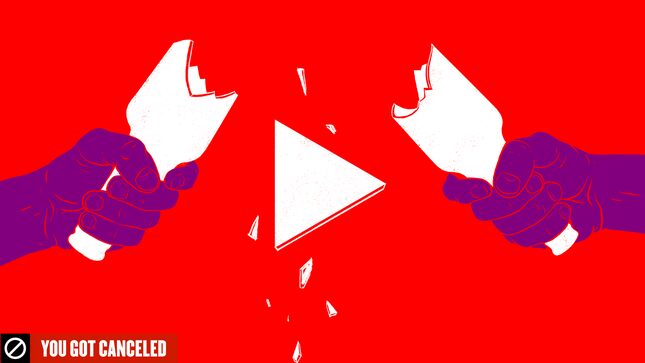A Never Ending Feud: How 'Canceling' Built YouTube
Latest
Illustration: Jim Cooke (G/O Media)
The greatest tale of YouTube cancelation this year started with an Instagram Story. James Charles, one of the most familiar faces in the BeauTuber community, posted an #ad for Sugar Bear Hair vitamins while at Coachella. Innocuous enough except, of course, for the fact that the brand is a direct competitor to longtime friend Tati Westbrook’s beauty-supplement, Halo Beauty. Westbrook retaliated with her own Instagram Story, saying she felt “used” by a “good friend.” Her critique went beyond the promotion: Westbrook accused him of seducing young straight boys with his fame. Charles apologized, other YouTubers broke into the fold to express their opinions, align by side, and, of course, draw eyeballs to their own channels. Eventually both Charles and Westbrook posted ridiculously lengthy vlogs back and forth, detailing their long history of private betrayals.
After Westbrook’s 43-minute “Bye Sisters” video post, the first of their he-said she-said vlog series, James Charles was hit hard. At the height of the drama, he dropped from 16.5 million to 13.4 subscribers. (Charles now holds the record for most subscribers lost in 24 hours: just under two million.)
Within a week, however, his account had rebounded: Charles’s “cancelation” lasted all of seven days. Westbrook posted a follow-up video requesting her subscribers leave Charles alone; he uploaded his own response. But the mainstream media outlets that had posted regular updates on the supposed feud had already had an effect. Westbrook doubled her 5 million followers, and currently sits at a healthy 9.7 million. For both, the maxim “all press is good press” became a reality: the supposed bad behavior was actually a swift path to notoriety.
If one theme has defined YouTube in 2019, it is the fallacy of cancel culture. On YouTube, “canceling” varies wildly from its use elsewhere, where it is often weaponized by a man accused of abusing his power in an attempt to displace blame. In that space, it’s easy to see that canceling is a vague grasp at a defense: regardless of what criticism they may face, those guys always come back. Redemption is inevitable for powerful men.
But on YouTube, canceling is a well-worn tool. Entire networks of drama channels are built to sustain these often fabricated beefs, an obvious play to the numbers. The more infighting between famous vloggers, the more conversation surrounds them, the more views they rake in, the more money they make. As my colleague Megan Reynolds wrote earlier this year, Charles and Westbrook essentially expanded this reality TV trope—fighting for the sake of ratings-making drama—for YouTube.
There is, of course, a difference in expectation. Reality TV obsessives understand that the medium is highly stylized and any truths are stretched for dramatic effect. But YouTube is, by nature, dishonest. The platform is meant to be a democratizing force, helping creators build brands by being themselves. So fights between YouTubers register as more authentic than, say, whatever conflict drove the kids of The Hills mad.
On YouTube, such fights are portrayed as emotional disputes between long-lasting friends—though, think about it, intimate altercations usually happen behind closed doors, in person. The YouTube impulse is to put former friends on blast, to “cancel” one another while knowing well that an online audience has a short memory. Soon enough, some other social media disaster will occupy the attention of those invested in the inner-workings of web celebrity. In the meantime, there are followers to be gained.
And now, YouTubers have taken it to the next level by demanding the end of “cancel culture,” even as they continue to thrive off of it. In 2019, there were too many cancelations to count; most were resolved almost as quickly as they hit the trending page. Because of that, I thought it would be helpful to draft a highly abridged taxonomy of YouTube cancelations, 2019 edition.-

-

-

-

-

-

-

-

-

-

-

-

-

-

-

-

-

-

-

-

-

-

-

-

-

-

-

-

-

-

-

-

-

-

-

-

-

-

-

-








































